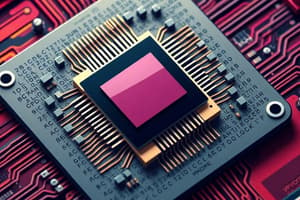Podcast
Questions and Answers
Which architectural style offers faster performance due to simple, yet numerous instructions?
Which architectural style offers faster performance due to simple, yet numerous instructions?
- MIPS
- ARM
- CISC
- RISC (correct)
What does ISA specify in a CPU?
What does ISA specify in a CPU?
- The color of the CPU
- The manufacturer of the CPU
- The size of the CPU
- Types of instructions a CPU can execute (correct)
What is included in the memory hierarchy of a computer system?
What is included in the memory hierarchy of a computer system?
- CPU's registers, cache, main memory, secondary storage (correct)
- Sound card, graphics card, processor
- Keyboard, mouse, printer, monitor
- CD drive, USB ports, Ethernet port
Which ISA is the most widely used today?
Which ISA is the most widely used today?
What does CPU stand for in computer terminology?
What does CPU stand for in computer terminology?
What is the primary purpose of a tiered storage approach in a computer system?
What is the primary purpose of a tiered storage approach in a computer system?
Why are Input/Output (I/O) systems crucial for a computer?
Why are Input/Output (I/O) systems crucial for a computer?
How does the system bus contribute to a computer's operation?
How does the system bus contribute to a computer's operation?
Why is it important for components to be compatible with the bus's specifications?
Why is it important for components to be compatible with the bus's specifications?
How do memory buses contribute to a computer's efficiency?
How do memory buses contribute to a computer's efficiency?
Flashcards are hidden until you start studying
Study Notes
Exploring Computer Organization: CPU Architecture, I/O Systems, ISA, Memory Hierarchy, and System Bus Design
Understanding computer organization helps us grasp how digital machines work at a fundamental level. Within this realm, several key concepts and subsystems form the bedrock of modern computing. Let's delve into these topics, examining CPU architecture, input/output systems, instruction set architecture, memory hierarchy, and system bus design.
CPU Architecture
The Central Processing Unit (CPU) is the brain of a computer. Its design is crucial to determining how effectively it can execute instructions and complete tasks. Two primary architectural styles exist: RISC (Reduced Instruction Set Computer) and CISC (Complex Instruction Set Computer). RISC CPUs offer faster performance due to their simple, yet numerous instructions, whereas CISC CPUs offer more flexibility through their versatile, complex instructions.
Instruction Set Architecture (ISA)
The Instruction Set Architecture specifies the types of instructions a CPU can execute. ISAs define the low-level operations a CPU can perform, such as adding two numbers, reading from memory, or jumping to a different part of the code. The x86 ISA, for example, is the most widely used ISA today.
Memory Hierarchy
Memory hierarchy refers to the organization of storage within a computer, which includes the CPU's registers, cache, main memory (RAM), and secondary storage (such as hard drives). Data is stored at different levels, with faster storage being closer to the CPU, and slower, larger storage being further away. This tiered storage approach helps optimize performance.
Input/Output Systems
Input/Output (I/O) systems enable communication between the computer and external devices. These systems facilitate data exchange between the computer's internal components and peripherals such as keyboards, displays, storage devices, and networks. I/O interfaces are crucial for a computer to interact with its environment.
System Bus Design
The system bus serves as the communication highway within a computer, facilitating the exchange of data between components. Buses are available in various types, including system, memory, and peripheral buses. Buses operate at varying speeds depending on their design, and the components they connect must be compatible with the bus's specifications.
By understanding these subtopics, we can better appreciate the intricate workings of computer organization. This understanding is essential for software and hardware developers alike, as it informs their design decisions and helps them create more efficient, powerful, and versatile computers.
This article is meant to serve as a basic introduction to computer organization. As you delve deeper into these topics, you'll discover a wealth of information that will help you understand and appreciate the fascinating world of computing.
Studying That Suits You
Use AI to generate personalized quizzes and flashcards to suit your learning preferences.




